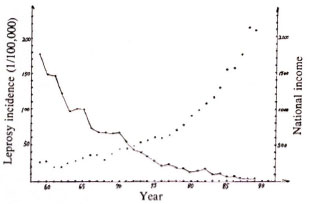- Volume 61 , Number 4
- Page: 631–2
Leprosy-economy-environment; might we predict leprosy incidence f rom this point of view?
To the Editor:
It is known that direct contact is not an important element in leprosy infection since many who frequently have contact with leprosy patients (such as leprosy doctors) do not have a high leprosy incidence under conditions which offer no specific protection against the disease. On the other hand, there is a higher leprosy incidence in the family of leprosy patients compared to families without a history of leprosy. Even though multidrug therapy (MDT) is a powerful tool to cure active patients, MDT also might not be an important element for reducing leprosy incidence because leprosy in Norway was eradicated before any antileprosy drug was found. No one knows with certainty the source of leprosy in nature or how it reaches the human body. It is very difficult to predict leprosy incidence without knowing the micro-mechanism of the disease.
There is a problem which has puzzled us for a long time. Why do we not know more about the source of leprosy in nature for such an old disease with over a thousandyear history in such a high civilized society with good communication, numerous precise instruments and superb techniques (some of those can even be used to do experiments at the molecular biology level), and a multitude of skilled doctors? This situation might suggest that leprosy is a disease greatly different from other diseases so that we cannot use the methods applied to other diseases for research into leprosy. In other words, we are used to researching diseases on the micro-mechanism level. Perhaps we need to try to do leprosy research on a macro-mechanism level.
It is well known that a higher leprosy incidence usually occurs in poor economic countries and a lower leprosy incidence occurs in developed countries. Leprosy in China has a history of over 2000 years, but its incidence has decreased greatly since 1949 when the People's Republic of China was founded. Meanwhile, economic conditions of China have improved. In the past 10 or more years, Guangzhou District, with an economic growth rate of over 10% per year, has become one of the economically fastest growth areas in the world. This makes it possible to make a correlation analysis between the economy and leprosy incidence. The Figure shows that leprosy incidence decreases along with increases in the economy.

The figure. Economic growth and leprosy incidence in Guangzhou District, 1960-1990. (---) = Leprosy incidence (per 100,000); (.....) = economic growth (per capita income corrected for price changes).
We tried to make a correlation analysis between leprosy incidence and the economy, and the results show p {| r = -0.7311 | > r = 0.456} = 0.01 for Guangzhou City. If a logarithmic transformation was used for the leprosy incidence, the result is p {|r = -0.957| > r = 0.456} = 0.01 for Guangzhou City. Thus, there is a high inverse correlation between leprosy incidence and the economic index.
From the economic viewpoint, we can explain why leprosy in Norway was eradicated before any antilcprosy drug was found and why leprosy in Japan was not eradicated at that time even though its strict isolation policy was being carried out but afterward leprosy naturally passed away along with development of the Japanese economy.
Naturally we think that the economy itself has no direct association with leprosy incidence from the medical viewpoint. The actual elements affecting leprosy incidence should be environmental factors. Human activities and their productive ability control the living environment of human beings (such as the conditions of the rooms, living habits, food sources and variety, etc.). The living environment also controls the health conditions of human beings who live in this environment. Health and environment affect each other and form a human-environment system with the feature of mutual feedback. Leprosy incidence is only a representation of the level of the system in a way. Because the economic index can be regarded as an approximate indicator for the level of the living environment of human beings, leprosy incidence is highly inversely related to the economy. Of course these thoughts are only speculations, and there is a long way to go to reveal the precise relationship between leprosy and the living environment. Maybe it is beyond our present ability.
For many years, people have been looking for a valid and simple indicator to predict leprosy incidence in order to plan for leprosy control. As a result of our research, is it possible to predict leprosy incidence by using an economic index? If it is true, data on an authoritative economic index published by the government every year can be very useful. We made a logarithmic model to predict the leprosy incidence in Guangzhou, and the result showed that leprosy incidence will decrease to below 0.5/100,000 by 1996 in Guangzhou according to present economic development trends and the government plan. Our research might also suggest that, due to economic development, leprosy in Guangzhou will be eradicated in the near future. One is reminded of an old Chinese proverb which says, "Daybreak will be coming whether the cock calls it or not."
- Zhao Di, M.D.
Doctor-in-Charge
- Nong Yuewen, M.D.
Vice-Director
- Zhong Jingzeng, M.D.
Director
Guangzhou Dermatologic Institute
3 Hengzhigang
Luhu Road
Guangzhou 510060
People's Republic of China